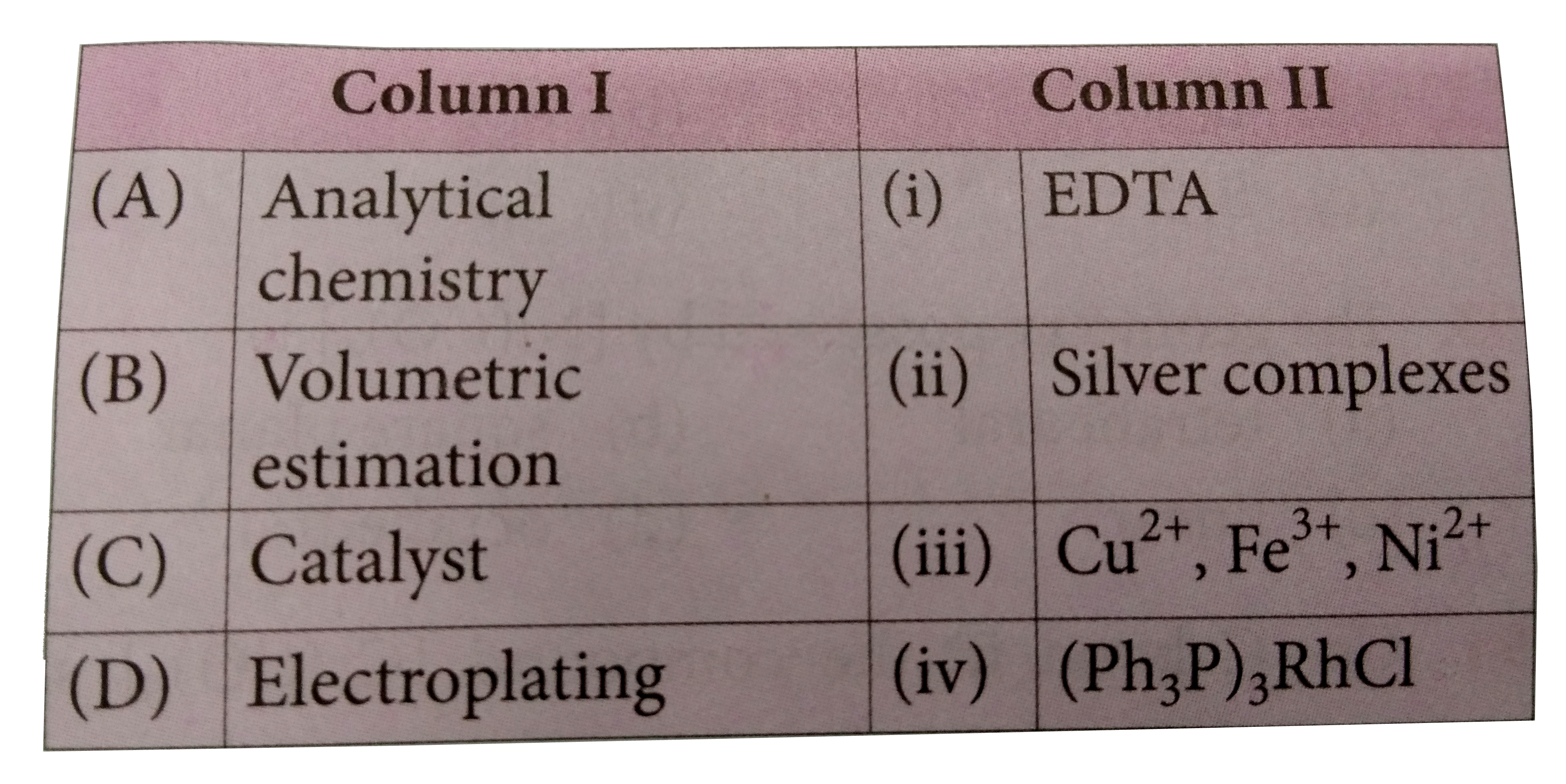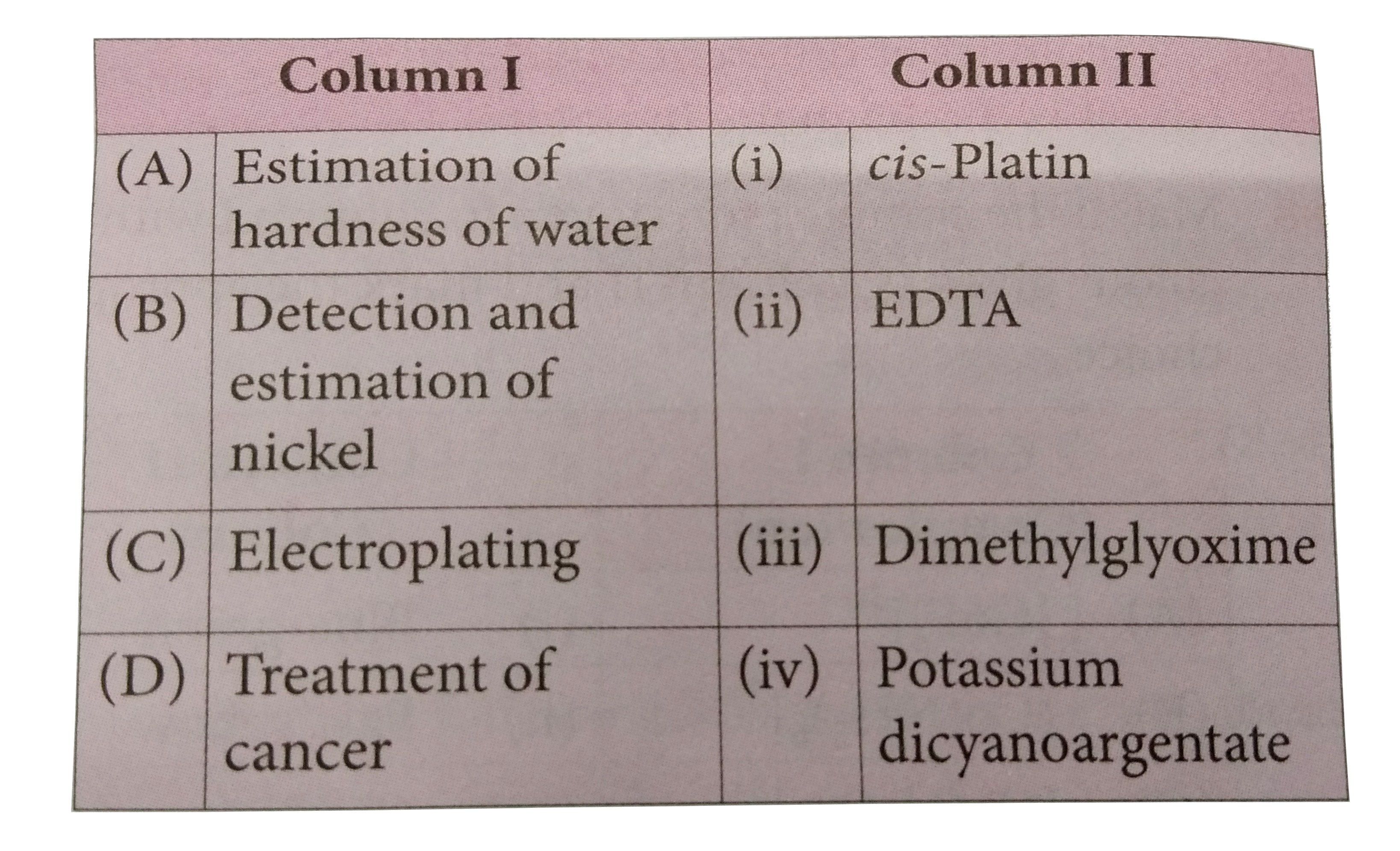Complete Solutions to MCQs of chapter COORDINATION COMPOUNDS of Class 12 book with complete answers and questions
| Class 12 | CHEMISTRY |
| Chapter | COORDINATION COMPOUNDS |
| NCERT FINGERTIPS | MCQs |
| Number Of Questions | 93 |
| Academic Year | 2023-24 |
Copper sulphate dissolves in ammonia due to the formulation of
01:35View SolutionConsider the following isomers.
(i) [Pt`(NH_(3))_(4)Cl_(2)]Br_(2) " " (ii) [Pt (NH_(3))_(4) Br_(2)]Cl_(2)`
(iii) `[Co(NH_(3))_(4)Cl_(2)] NO_(2)`
Which of the following observations is correct ?06:31View SolutionThe number of ions given by `[Pt(NH_(3))_(6)]Cl_(4)` in aqueous solution will be
01:39View SolutionA coordination compound X gives pale yellow colour with `AgNO_(3)` solution while its isomer Y gives white precipitate with `BaCl_(2)` . Two compounds are isomers of `CoBrSO_(4)* 5NH_(3)` . What could be the possible formula of X and Y ?
06:24View SolutionA solution containing 2.675 g of `CoCl_(3).6NH_(3)` (molar mass = 267.5 g `mol^(-1)` is passed through a cation exchanger. The chloride ions obtained in solution are treated with excess of `AgNO_(3)` to give 4.78 g of AgCl (molar mass = 143.5 g `mol^(-1)` ). The formula of the complex is (At.mass of Ag = 108 u ) .
04:43View SolutionWhen each of the following complex salts is treated with excess of `AgNO_(3)` solution, which will give the maximum amount of AgCl
03:46View SolutionArrange the following complexes in the increasing order of conductivity of their solution
`[Co(NH_(3))_(3)Cl_(3)], [Co(NH_(3))_(4)Cl_(2)]Cl, [Co(NH_(3))_(6)]Cl_(3), [Cr(NH_(3))_(5)Cl] Cl_(2)`03:38View SolutionA coordination compound `CrCI_(3).4H_(2)O` precipitates `AgCI` when treated with `AgNO_(3)` The molar conductance of its solution corresponds to a total of two ions Write the structural formula of the compound and name it .
04:03View SolutionAccording to Werner's theory of coordination compounds ,
04:14View SolutionAccording to Werner' s coordination theory, there are two kinds of valence primary or ______ and secondary or _____The former type of valency is ______while the latter type is______ .
05:48View SolutionWhich of the following primary and secondary valencies are not correctly marked against the compound ?
02:26View SolutionWhen aqueous solution of potassium fluoride is added to the blue coloured aqueous `CuSO_(4)` solution , a green precipitate is formed . This observation can be explained as follows .
05:07View SolutionWhen excess of aqueous KCN solution is added to an aqueous solution of copper sulphate , the complex `[Cu(CN)_(4)]^(2-)` is formed . On passing `H_(2)S` gas through this solution no precipitate of CuS is formed because
05:48View SolutionAmmonia acts as a very good ligand but ammonium ion does not form complexes because
03:04View SolutionThe denticity of the ligand `N(CH_(2)CH_(2)NH_(2))_(3)` is
01:57View SolutionWhich of the following is a tridentate ligand?
02:34View SolutionAmong the following which are ambidentate ligands?
(i) `NO_2^(-)`
(ii) `NO_3^(-)`
(iii) `C_2O_4^(2-)`
(iv) `SCN^(-)`04:02View SolutionWhich of the following ligand gives chelate complexes ?
04:23View SolutionWhich of the following is not a neutral ligand ?
02:38View SolutionWhich of the following ligands will not show chelation ?
02:31View SolutionThe coordination number and the oxidation state of the element 'E' in the complex `[E(en)_2(C_2O_4)]NO_2` (where `(en)` is ethylenediamine) are, respectively
02:51View SolutionThe charges x and y on the following ions are
`(i) [Co(NH_(3))_(2) Cl_(4)]^(x) " " (ii) [Fe(CN)_(6)]^(y)`
(Oxidation state of Co is +3 and Fe is + 2 in their respective complexes.)01:26View SolutionIdentify the statement which is not correct .
02:36View SolutionWhich of the following is not correctly matched ?
03:41View SolutionWhich of the following rules is not correct regarding IUPAC nomenclature of complex ions ?
01:48View SolutionThe correct IUPAC name of the coordination compound `K_(3) [Fe(CN)_(5) NO]` is
01:49View SolutionThe correct IUPAC name of the following compound is `[Cr(NH_(3))_(5)(NCS)][ZnCl_(4)]`
03:58View SolutionCorrect formula of tetraamminechloronitroplatinum (IV) sulphate can be written as
02:25View SolutionWhich of the following does not depict the correct , name of the compound ?
03:05View SolutionHexaamminenickel(II) hexanitrocobaltate(III) can be written as
02:39View SolutionWhich among the following will be named as dibromidobis (ethylene diamine) chromium (III) bromide ?
01:38View SolutionThe formula of the complex diamminechloro-(ethylenediamine) nitroplatinum (IV) chloride is
04:03View SolutionThe name of the compound `[Co(NH_(3))_(5) NO_2]Cl_2` will be
04:37View SolutionHow many geometrical isomers are there for
(a)`[Co(NH_(3))_(2)CI_(4)]^(Θ)`
(b) `[AuCI_(2)Br_(2)]^(Θ)` (square planar) (c ) `[CuCI_(2)Br_(2)]^(2-)` (tetrahedral) .03:00View SolutionWhich of the following will not show geometrical isomerism ?
03:20View SolutionFor the square planar complex [M(a) (b) (c ) (d)] (where M = central metal and a, b, c and d are monodentate ligands), the number of possible geometrical isomers are
03:30View SolutionWhich of the following complex species is not expected to exhibit optical isomerism ?
08:32View Solution`[Co(NH_(3))Cl(en)_(2)]^(2+)` exist which isomerism ?
03:02View SolutionWhich of the following gives the maxium number of isomers?
04:07View SolutionWhich of the following pair of compounds is a pair of enantiomers
04:39View SolutionWhich of the following compounds exhibits linkage isomerism?
04:24View Solution`[Pt(NH_(3))_(4)][CuCl_(4)]` and `[Cu(NH_(3))_(4)][PtCl_(4)]` are known as
04:47View SolutionWhich of the following complex will give white ppt. with `BaCl_(2)` solution ?
01:35View SolutionThe Compounds `[Cr(H_(2)O)_(6)]CI_(3)` , `[Cr(H_(2)O)_(5)CI]CI_(2)` . `H_(2)O` and `[Cr(H_(2)O)_(4)CI_(2)]` . `2H_(2)O` exhibit
03:54View SolutionWhich of the following pairs of isomers is not correctly matched with its type of isomerism ?
05:57View Solution`CrCl_(3) * 6H_(2)O` exists in different isomeric forms which show different colours like violet and green . This is due to
04:52View SolutionWhat type of isomerism exists in the following pairs of complexes ?
(i) `[Co(NH_(3))_(5)NO_(3)]SO_(4)` and `[Co(NH_(3))_(5) SO_(4) ] NO_(3)`
(ii) `[Co(en)(H_(2)O)_(2) Cl_(2)] Cl` and `[Co(en) (H_(2)O) Cl_(3) ] H_(2)O`06:22View SolutionThe anion `[Co(C_(2)O_(4))_(3)]^(3-)` involves hybridization
05:15View SolutionWhich of the following sets of examples and geometry of the compounds is not correct ?
03:26View SolutionWhich of the following is correct ?
03:15View SolutionMark the incorrect statement .
03:04View SolutionWhich of the following facts about the complex `[Cr(NH_(3))_(6)]Cl_(3)` is wrong ?
04:57View SolutionWhich of the following molecules has a regular tetrahedral shape?
04:54View SolutionMark the correct statements regarding the geometry of complex ions .
(i) The geometry of the complex ion depends upon the coordination number .
(ii) If coordination number is 6 , the complex is octahedral .
(iii) If coordination number is 4 , the geometry of the complex may be tetrahedral or square planar .02:16View SolutionThe complex ion which has no 'd'-electrons in the central metal atom is
View SolutionGive reason for the statement `[Ni(CN)_(4)]^(2-)` is diamagnetic while `[NiCl_(4)]^(2-)` is paramagnetic in nature .
03:28View SolutionThe lowest value of paramagnetism is shown by
04:21View SolutionExplain the following: (i)
[CoF_(6)]^(3-)` is paramgnetic but `[Co(CN)_(6)]^(3-)` is diamagnetic .01:36View SolutionDeduce the structures of `[NiCl_(4)]^(2-)` and `[Ni (CN)_(4)]^(2-)` considering the hybridisation of the metal ion. Calculate the magnetic moment (spin only) of the species.
04:41View SolutionWhich of the following has largest paramagnetism ?
03:52View SolutionUsing valence bond theory , the complex `[Cr(H_(2)O)_(6)]^(3+)` can be described as
04:38View SolutionWhich of the following descriptions about `[FeCl_(6)]^(4-)` is correct about the complex ion ?
02:41View SolutionWhen excess of ammonia is added to `CuSO_4` solution, the deep blue coloured complex is formed. Complex is
05:03View SolutionPick out the correct statement with respect to `[Mn(CN)_(6)]^(3-)`:
06:03View SolutionAmong the following the compound that is both paramagnetic and coloured is
06:52View SolutionThe spin only magnetic moment value of `Cr(CO)_(6)` is
03:01View SolutionWhich of the following complexes will show maximum paramagnetism ?
02:05View SolutionElectronic configuration of `[Cu(NH_(3))_(6)]^(2+)` on the basis of crystal field splitting theory is
02:46View SolutionWhich of the following energy level diagram for `[FeF_(6)]^(3-)` is correct on the basis of crystal field theory ?
03:23View SolutionIn `[NiCl_(4)]^(2-)` ,the number of unparied electron is
03:19View SolutionWhich of the following shell from an octahedral complex
03:43View SolutionThe value of 'spin only' magnetic moment for one of the following configuration is `2.84B.M.` The correct one is:
05:35View SolutionWhich of the following statements is/are correct ?
(i) In octahedral complexes , `t_(2 g)` orbitals possess low energy as compared to `e_(g)` orbitals .
(ii) In tetrahedral complexes , `t_(2 )` orbitals possess high energy as compared to e orbitals .
(iii) In octahedral complexes , `e_(g)` orbitals possess low energy as compared to `t_(2 g)` orbitals .02:57View Solution`[FeF_(6)]^(3-)` is paramagnetic due to presence of unpaired electrons in the complex . The five electrons remain unpaired because
02:53View Solution`[Co(C_(2)O_(4))_(3)]^(3-)` is a
02:16View SolutionWhat are the correct oxidation state , coordination number , configuration , magnetic character and magnetic moment of `K_(4)[Mn(CN)_(6)] ? `
03:57View SolutionWhich of the following statements is correct about `[Co(H_(2)O)_(6)]^(2+)` complex ?
05:01View SolutionThe increasing order of the crystal field splitting power of some common ligands is
01:29View SolutionWhat is crystal field splitting energy? How does the magnitude of `triangle_(0)` decide the actual configuration of d orbitals in a coordination entity?
07:18View SolutionWhy are low spin tetrahedral complexes not formed ?
03:47View SolutionA substance appears coloured because
01:38View Solution`CuSO_(4).5H_(2)O` is blue in colour while `CuSO_(4)` is colourless. Why ?
02:32View Solution`[Fe(CN)_(6)]^(4-)` and `[Fe(H_(2)O)_(6)]^(2+)` are of different colours in dilute solutions why?
02:24View SolutionExplain why hexacayano complexe of metals in their +2 oxidation state are usually yellow , but the corresponding hexa aqua compounds are often blue or green .
03:24View SolutionThe number of bridging CO ligand(s) and Co-Co bond(s) in `Co_(2)(CO)_(8)`, respectively
02:18View Solution`Ni(CO)_(4)` is
01:38View SolutionThe oxidation state of chromium in `Cr(CO)_(6)` is
01:27View SolutionThe correct structure of `Fe (CO)_(5)` is ?
03:15View SolutionSelect the true statement from the following for metal carbonyls ?
05:28View SolutionMark the incorrect match .
00:57View SolutionWhich of the following statements is incorrect regarding the importance of coordination compounds in biological systems ?
02:04View SolutionMatch the column I with the column II and mark the appropriate choice .
 02:51View Solution
02:51View SolutionMatch the column I with column II and mark the appropriate choice .
 02:49View Solution
02:49View Solution
MCQs questions and complete solutions for chapter COORDINATION COMPOUNDS of MTG CHEMISTRY (ENGLISH) of Class 12
All Exercises from NCERT FINGERTIPS Class 12 CHEMISTRY COORDINATION COMPOUNDS
- Application Of Coordination Compounds
- ASSERTION & REASON
- Assertion And Reason
- Bonding In Coordination Compounds
- Bonding In Metal Carbonyls
- Definition Of Some Important Terms Pertaining To Coordination Compounds
- Higher Order Thinking Skills
- HOTS
- Isomerism In Coordination Compounds
- MCQs
- NCERT Exemplar
- NCERT EXEMPLAR PROBLEMS
- Nomenclature Of Coordination Compounds
- Warners Theory Of Coordination Compound
